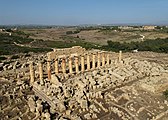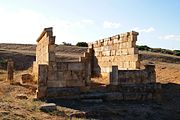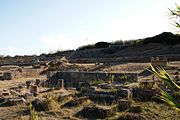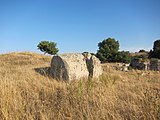 | WARNING: Due to the outbreak of the infectious disease COVID-19 (see coronavirus pandemic), caused by the virus SARS-CoV-2, also known as coronavirus, there are travel restrictions worldwide. It is therefore of great importance to follow the advice of the official bodies of Belgium and Netherlands to be consulted frequently. These travel restrictions may include travel restrictions, closure of hotels and restaurants, quarantine measures, being allowed to be on the street for no reason and more, and can be implemented with immediate effect. Of course, in your own interest and that of others, you must immediately and strictly follow government instructions. |

The Archaeological Park Selinunte (Italian: Parco archeologico Selinunte) is located in the southwest of the island Sicily in the Italian province Trapani. The territory is part of the municipality Castelvetrano.
Info
| climate | Jan | Feb | Mar | April | May | jun | july | aug | sep | Oct | Nov | Dec |
|---|---|---|---|---|---|---|---|---|---|---|---|---|
| average maximum (°C) | 15 | 15 | 17 | 19 | 23 | 27 | 29 | 30 | 28 | 24 | 19 | 16 |
| average minimum (°C) | 8 | 7 | 8 | 10 | 14 | 17 | 20 | 21 | 19 | 18 | 12 | 9 |
In the spring the park is at its best with seas of wild flowers and with far fewer tourists than in high season.
History
Selinunte was founded around 700 BC. founded by settlers from the Greek Megara (an independent city-state 35 km from Athens). Around 580 BC. a conflict with Elymians (a Sicilian indigenous people) broke out segesta. In order to gain support, the Greeks entered into an alliance with Carthage and later with Syracuse. Even in times of peace, the conflict with Segesta continued to smolder. In 415 BC. Segesta got her ally Athens as far as sending an expedition. See you at a meeting with the city Selinunte however, it did not come. In 409 BC. landed out Motoya expelled Carthegers at Libyaeum (Marsala) and engaged Selinunte, which was captured after a ten-day siege. After the city walls were demolished, the residents were allowed to return. An ally of the Carthaginians, the city gained in strength and grandeur. After the first Punic War against the Romans, the Carthaginians retreated to Lilybaeum and destroyed it around 250 BC. the city. Selinunte was never rebuilt and fell into ruins over the centuries. In the 19th century, the ruins of the city were barely recognizable under the scrub. In the 20th century, the temples on the eastern hill were excavated. In 1950, temple E controversially reconstructed and was completed with the excavations of the acropolis started.
Arrive
By plane
- Trapani (Vincenzo Florio Airport), ☎ 39 0923 610111. IATA:TPS, ICAO:LICT. Lumia Auto bus company provides the connection from Trapani Birgi Airport to Castelvetrano. Duration: 1 hour, Price: €8.60 on working days 3x daily.
By car
From Trapani the A29 to the south, then exit Castelvetrano and about SS115 nasty Marinella di Selinunte. In the village, at the roundabout, take the first exit to the right. After 50 m you will find the entrance to the park at a parking lot.
By train
The nearest train station is in:
- Castelvetrano. Information about train connections at Trenitalia. From here you can take a bus or car to the Selinunte Archaeological Park.
By bus
In Sicily there are 3 companies that provide bus services. Sais, ast and Interbus, which connect the main cities. The bus company Salemic maintains services between Castelvetrano and Marinella di Selinunte.
Travel around
By bus
A tourist train (Trenino, €6.00) travels across the site. Don't do this if you are in good shape.
on foot
You have more freedom on foot. Because it can be very hot, it is advisable to go as early as possible. There is little shade. Wear good walking shoes and bring plenty of water.
To look at
- Parco Archeologico Selinunte (the marker on the map indicates the entrance), ☎ 39 0924 46540. 09:00-19:00 (Checkout closes at 18:00). It archaeological area of Selinunte consists of several parts. The eastern hill with the temples E, F and G, as the crow flies 1 kilometer away by the sea the ruins of the old walled city with the acropolis and Temples A, B, C, D, and O. Further west is the sanctuary Malaphoros with a necropolis. In the northern part is a large necropolis. There are toilets at the Oostheuvel and at the Acropolis. €6,00.
Acropolis
- city wall. The city wall was restored after the destruction by the Carthaginians and surrounded the entire old city. Even today, many remains can be seen, including parts at the northern city gate.
City wall entrance North side
- Temple O. Only sparse remains of this southernmost temple on the Acropolis can be seen. The temple had an area of 40.2 x 16.2 m (14 x 6 columns).
- Temple A. This temple is identical to temple O. The altar has been recovered as well as spiral staircases leading to the naos (the holy of holies of the temple).
- Temple B. With an area of 8.4 x 4.6 m (4 columns at the front), this is the smallest temple dedicated to Empedokles Founded. The colorful temple was built in 1824 by J.I.Hittorf discovers. As a result of this temple, he conducted research into the polychromy (use of color in Greek architecture) that brought the world of archeology to other insights.
- Temple C. This temple that on Apollo is attributed has an area of 63.7 x 24 m (17 x 7 columns) and is the oldest and most glorious temple of Selinunte. Some Metopes are in the archaeological museum of Palermo. On the north side are 12 more columns.
- Temple D. The 56 x 24 m (6 x 13 columns) temple stands further north.
- Megaron (Temple M). This 17.8 x 6.3 m building was built in 580 BC. built. A Megaron is a sanctuary.

Temple A

Temple C and on the right the small temple B

Temple D
East Hill (Collina orientale)
- Temple E. The classic Doric Temple E, which Hera is attributed, has an area of 70.2 x 27.6 m (15 x 6 columns) and was built between 460 - 450 BC. built. Four metopes (decorative elements) are in the archaeological museum of Palermo. The temple was reconstructed in 1959 in a controversial way. Most tourists don't care about that. The temple provides a spectacular picture of its heyday and it is therefore understandable that this temple is the most photographed object in the park.
- Temple F. This is the smallest temple with an area of 61.8 x 24.4 m (6 x 14 columns). It is believed that the temple Dionysus is attributed. He was born between 550 - 520 BC. built. The stones of the temple were used for other purposes after its collapse. Metopen of this temple are also housed in the archaeological museum of Palermo.
- Temple G. The Temple of Zeus With a surface area of 113 x 54 m (17 x 8 columns), it is the largest in Selinunte and one of the largest from Greek antiquity. Its construction is in 530 BC. started and it is believed that, until the destruction of the city, construction had not yet been completed.
  Temple E |   Temple F |   Temple G |
Sanctuary of Malophoros
This section of the park lays further west and is via a path from the Acropolis across the Modinone reach the river.
- Temple N (Sanctuary of Hera). A small temple structure with a large altar dedicated to the goddess Hera.
- Sanctuary of Demeter Malophoros. This Megaron is on Demeter Malophoros dedicated. 12000 terracotta motif figures were found here.
- Temenos by Zeus Meilichios: Immediately to the right of the sanctuary of Demeter Malophoros is an altar in honor of Zeus.
- Source of Gaggera / Antiquarium: in a small Museum, which is partly built over the ancient edge of the well, local finds are exhibited.

Temple N

Sanctuary of Demeter Malophoros

Sanctuary of Zeus Meilichios
necropolis
- necropolis. Parts of the tomb paintings found at the necropolis on the east side of the Modinone are on display in the visitor center near the Acropolis.
To do
To buy
Opposite the entrance are souvenir stalls where you can buy ceramics with archaeological images. Postcards may be a good choice.
Food
Opposite the park entrance you can buy soft drinks and sandwiches. It is possible that you will encounter a peddler within the park, but it is better not to rely on that. There are no restaurants within the boundaries of the park for more extensive food. In Marinella di Selinunte you can go to several places:
- Olimpo (S.A.S. Di Maggio Benito & C), Via Giovanni Caboto 132, Marinella di Selinunte, ☎ 39 0924 46876.
- Fontana Natal, Via Marco Polo 49, Marinella di Selinunte, ☎ 39 0924 46211.
- Ristorante Giulio Cesare (Di Cavarretta Emmanuela), Via degli Argonauti 18, Marinella di Selinunte, ☎ 39 0924 46335.
Going out
- Bar Pinguino, Via del Cantone, 3 (In Marinella by the marina), ☎ 39 0924 46231, e-mail: [email protected].
stay overnight
Hotels
Marinella di Selinunte
- Hotel Garzia (Hotel Miramare), Via Antonio Pigafetta 2, Marinella di Selinunte, ☎ 39 0924 46024, e-mail: [email protected]. Some rooms at the front have a large terrace with a sea view. From €70.00.
- Hotel L'Oasi di Selinunte, Via Pitagora, Marinella di Selinunte, ☎ 39 0924 46885, e-mail: [email protected]. 4 star hotel with s.p.a. and swimming pool. From €65.00 p.p..
- Hotel Admetoz, Via Palinuro 3, 91022 Marinella (TP), ☎ 39 0924 46796, fax machine: 39 0924 941055, e-mail: [email protected]. 4 star hotel
Triscina
- Triscinamare, Viale Mediterraneo 233, Triscina di Selinunte (TP), ☎ 39 0924 84082, e-mail: [email protected]. The hotel also has apartments and attached cottages. Large terrace with swimming pool. From €45.00.
Camping
- Camping Il Maggiolino, ss 115 Dir. A 106. Marinella di Selinunte (Not far from the park entrance), ☎ 39 0924 46044, e-mail: [email protected]. Also chalets for rent
Safety
The biggest enemy in the park can be the heat. Be prepared: wear a hat and sunglasses. Take enough water with you.
Contact
- Emergency number, ☎112.
- Law enforcement, ☎113.
- Fire Department, ☎115.
- roadside assistance, ☎116.
all around

- Cave di Cusa (Campobello di Mazara). Cave di Cusa (also called Rocche di Cusa mentioned) was an old quarry that was already in the 6th century BC. was used to make the stones for the city Selinunte to cut out. It is now an official archaeological tourist destination for which an entrance fee of €2.00 has to be paid. The place is located 3 km south of Campobello di Mazara, which is 12.5 km west of Marinella di Selinunte is. Especially in spring it is a beautiful place for a picnic.

Cave di Cusa
- Marinella di Selinunte. On the east side of the archaeological park is Marinella di Selinunte, a village belonging to the district of Castelvetrano. It is a tourist resort on a long sandy beach with a fishing harbor and marina. Every morning around 08:00 a fish auction takes place in Piazza Empedocle.
- Triscina di Selinunte. The seaside resort of Triscina di Selinunte is about 10 km on the west side of the park. It has extensive beaches and is free from mass tourism. Via the archaeological area it is only a 2 km walk between Marinella and Triscina.
- Tre Fontane. A few kilometers west of Triscina is Tre Fontana, in the summer a real seaside resort with many beach facilities and a water park (Acquasplash).
- Castelvetrano. Visit it Civic Museum in Castelvetrano with the Ephebo di Selinunte, a bronze statue from 480-460 BC. Address: Via Giuseppe Garibaldi 50, Phone: 39 0924 909605.
| This is a guide article . It contains a large amount of good, quality information about relevant attractions, entertainment venues and hotels. Dive in and make it a star article! |









